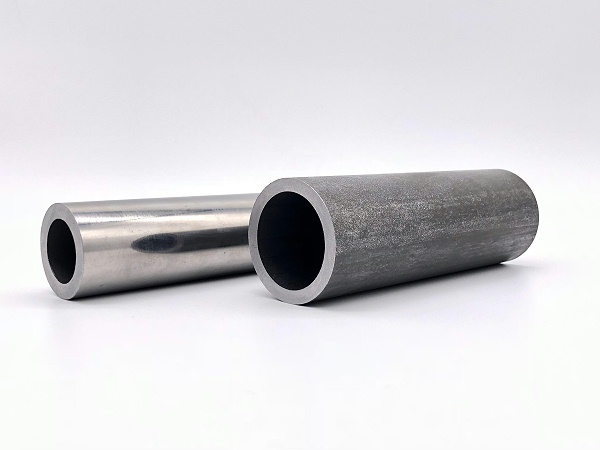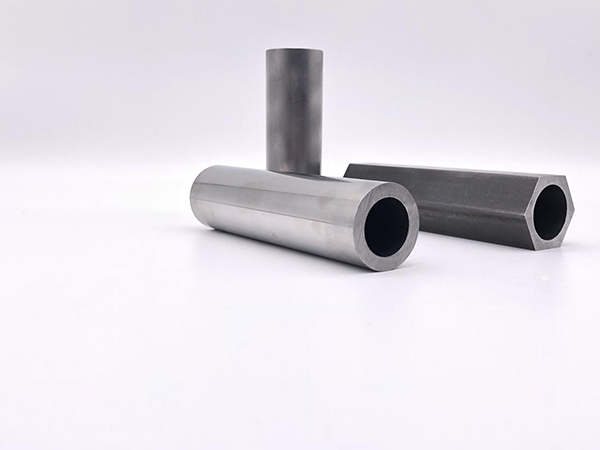The pickling and passivation of seamless steel pipes is a chemical reaction. Firstly, the oxide skin and rust on the steel surface can be removed through the pickling solution, while completing the passivation process. It can effectively prevent oxidation of seamless steel pipes and achieve the goal of corrosion prevention.
Before pickling and passivation of seamless steel pipes, it is necessary to remove oil, degrease, and impurities such as surface drawing compounds. After acid pickling and passivation, the surface of seamless steel pipes becomes uniformly silver white, greatly improving the corrosion resistance of stainless steel.
The phosphating of seamless steel pipes is the process of immersing seamless steel pipes in a phosphating solution (some acid phosphate based solutions) and depositing a crystalline phosphate conversion film on the surface that is insoluble in water. Phosphating is a process of chemical and electrochemical reactions to form a phosphate chemical conversion film, which is called a phosphating film to prevent metal corrosion to a certain extent;
Used for priming before painting to improve the adhesion and corrosion resistance of the paint film layer; Used for friction reduction and lubrication in metal cold working processes.
The “phosphating and saponification” of seamless steel pipes refers to a process of saponification after phosphating. It is generally used in machining processes such as drawing or stretching. After the phosphating film is generally 8-12 microns, it enters the saponification solution and is then pulled or stretched.
The purpose of saponification of seamless steel pipes is to further increase lubrication performance.
Brief operating procedures for acid pickling, phosphating, and saponification of seamless steel pipes: acid pickling → high pressure flushing → phosphating → high pressure water flushing → saponification → drying → transportation and stacking.
一、 Acid washing
1. Definition of pickling: Acids are used to remove iron oxide scale chemically at a certain concentration, temperature, and speed, which is called pickling.
2. Pickling classification: According to the type of acid, it is divided into sulfuric acid pickling, hydrochloric acid pickling, nitric acid pickling, and hydrofluoric acid pickling. Different media must be selected for pickling based on the material of the steel, such as pickling carbon steel with sulfuric acid and hydrochloric acid, or pickling stainless steel with a mixture of nitric acid and hydrofluoric acid. According to the shape of steel, it is divided into wire pickling, forging pickling, steel plate pickling, strip pickling, etc. According to the type of pickling equipment, it is divided into tank pickling, semi continuous pickling, fully continuous pickling, and tower pickling.
3. The principle of acid pickling: Acid pickling is the process of removing iron oxide scales from metal surfaces using chemical methods, hence it is also called chemical acid pickling. The iron oxide scales (Fe203, Fe304, Fe0) formed on the surface of steel pipes are insoluble alkaline oxides. When they are immersed in acid or sprayed on their surface, these alkaline oxides can undergo a series of chemical changes with the acid.
二、 Passivation
1. Passivation principle: The passivation mechanism can be explained by thin film theory, which suggests that passivation is due to the interaction between metals and oxidizing substances, generating a very thin, dense, well covered, and firmly adsorbed passivation film on the metal surface. This layer of film exists as an independent phase, usually a compound of oxidized metals. It plays a role in completely separating the metal from the corrosive medium, preventing the metal from coming into contact with the corrosive medium, thereby basically stopping the dissolution of the metal and forming a passive state to achieve anti-corrosion effect.
2. Passivation advantages:
1) Compared with the traditional physical sealing method, the passivation treatment has the characteristic of absolutely not increasing the thickness of the workpiece and changing the color, improving the precision and added value of the product, making the operation more convenient;
2) Due to the non reactive nature of the passivation process, the passivation agent can be repeatedly added and used, resulting in a longer lifespan and more economical cost.
3) The passivation promotes the formation of oxygen molecular structure passivation film on the metal surface, which is dense, stable in performance, and has self repairing effect in the air. Therefore, compared with traditional methods of applying rust prevention oil, the passivation film formed by passivation is more stable and corrosion resistant.
Most of the charge effects in the oxide layer are directly or indirectly related to the process of thermal oxidation.
In the temperature range of 800 → 1250 ℃, the thermal oxidation process using dry oxygen, wet oxygen, or water vapor has three continuous stages. Firstly, the oxygen in the environmental atmosphere enters the generated oxide layer, and then the oxygen diffuses internally through silicon dioxide. When it reaches the Si02 Si interface, it reacts with silicon to form new silicon dioxide.
In this way, the continuous process of oxygen entry diffusion reaction occurs, causing the silicon near the interface to continuously convert into silica, and the oxide layer grows towards the interior of the silicon wafer at a certain rate.
三、 Phosphating
Phosphating treatment is a chemical reaction that forms a layer of film (phosphating film) on the surface.
The phosphating treatment process is mainly used on metal surfaces, with the aim of providing a protective film to isolate the metal from air and prevent corrosion; It can also be used as a primer for some products before painting. With this layer of phosphating film, it can improve the adhesion and corrosion resistance of the paint layer, improve decorative properties, and make the metal surface look more beautiful. It can also play a lubricating role in some metal cold working processes.
After phosphating treatment, the workpiece will not oxidize or rust for a long time, so the application of phosphating treatment is very extensive and is also a commonly used metal surface treatment process. It is increasingly used in industries such as automobiles, ships, and mechanical manufacturing.
1. Classification and application of phosphating
Usually, a surface treatment will present a different color, but phosphating treatment can be based on actual needs by using different phosphating agents to present different colors. This is why we often see phosphating treatment in gray, color, or black.
Iron based phosphating: After phosphating, the surface will appear rainbow and blue, so it is also known as colored phosphorus. The phosphating solution mainly uses molybdate as the raw material, forming a rainbow colored phosphating film on the surface of steel materials. It is also mainly used for coating the bottom layer to achieve the anti-corrosion ability of the workpiece and improve the adhesion of the surface coating.
2. Process flow of acid pickling and passivation for seamless steel pipes
Seamless steel pipes are pickled and passivated. The secondary cold drawing of seamless steel pipes involves raw materials (capillary or finished pipes) → heading → pickling → phosphorus saponification (i.e. lubrication) → cold drawing. If there is a secondary cold drawing, it depends on the steel grade whether annealing is required or not.
Generally, low carbon steel does not require annealing. After secondary cold drawing, lubrication → cold drawing → annealing → straightening → cutting → finished product inspection → packaging and warehousing. Those with high quality requirements shall undergo acid pickling and passivation treatment.
The conventional process for acid pickling and passivation treatment of seamless pipes is to ensure the quality of acid pickling and passivation. At the beginning of acid pickling and passivation, it is necessary to consider the method of soaking in acid pickling and passivation solution. When it is not convenient to use liquid immersion, the method of applying acid pickling and passivation paste should be considered, but the method of applying acid pickling and passivation solution should not be used. When using the method of pickling and passivation solution immersion, it is necessary to test and analyze the soaking solution on schedule. The conventional process of pickling and passivation for steel pipes is as follows: → pickling → flushing → passivation (pool washing) → pre-treatment → → pickling and passivation (two in one) solution (pool washing) → flushing → post disposal → pickling and passivation (two in one) paste (pool washing) → 5.1 pre-treatment 5.1.1 Remove spatter, flux, dust, etc. on the surface of the weld seam and base material.
3. The role of acid pickling and passivation in seamless steel pipes
During the process of prefabrication, welding, testing, and heat treatment, the surface area of pipelines (carbon copper pipes, stainless steel pipes) may accumulate impurities such as iron oxide, welding slag, and oil scale, which can alter the corrosion resistance of the pipes.
The pipes can be cleaned with acid washing solution to remove dirt from the surface of the pipes; After further passivation treatment, a protective film against oxidation can be formed on the surface of the steel pipe, thereby improving its corrosion resistance and ensuring the normal operation of the production process.
4. Attention should be paid to pickling and passivating seamless steel pipes, and it is necessary to specifically mention the following points for pickling:
(1) Seamless steel pipes cannot be pickled with highly corrosive formulas, as local corrosion may occur. However, austenitic stainless steel can be pickled using the process of pickling bulk stainless steel.
(2) The formula containing chloride ions has a faster pickling speed and is only used for initial pickling of thick oxide films. After the initial pickling, use other pickling processes for a second pickling. Chloride ions can easily cause pitting corrosion of stainless steel. When preparing pickling solution, distilled water should be used as much as possible to prevent the mixing of chloride ions.
(3) When scrubbing, rolling, and pickling with pickling cream, the pickling surface should always be kept moist and not dry, otherwise the local acid concentration will be too high, resulting in cloud like patterns.
(4) In various pickling processes, it is necessary to strictly control the pickling temperature, time and other process conditions, otherwise insufficient pickling, excessive pickling, and even workpiece corrosion and scrapping may occur.
New Gapower Metal is professional in precision steel tube, the surface could be galvanized, phosphated and back paint. The steel pipes and steel bars are in stock, about 20,000 tons.
Post time: Nov-01-2023



